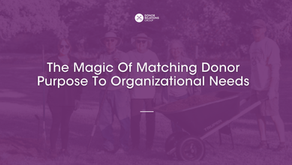3 Keys to Improving Your Impact Reports AND Donor Retention
- Lynne Wester

- Feb 1, 2024
- 3 min read
Updated: Feb 2, 2024

According to Penelope Burk’s Donor Centered Fundraising, 93% of individual donors would definitely or probably give again the next time they were asked if a charity thanked them promptly in a personal way, and followed up later with a meaningful report on the program they had funded. If you’re looking for the secret to donor retention, consider it found!
Did you catch that keyword, though? Meaningful. Donors don’t want a scripted, formulaic thank you note. They want meaningful expressions of how their gift made a difference. And who holds the key to that? The answer may surprise you, but it’s not you, it’s not your development operation, and it’s most likely not in the corner office of your administration building—it lies with the people who directly benefit from the donor’s generosity.
Your keys to donor retention are your beneficiaries. Your keys are sitting in a classroom, working in a laboratory, taking care of animals, and helping children and families right now. These are busy people who have a lot of other priorities, so as donor relations professionals, it’s our job to help them create the most meaningful donor updates while also being respectful of their time.
Here are a few tips and tricks to help make that happen:
1. Use a survey. For years, I had recipients of donor funds write handwritten thank you notes. I thought it was the gold standard, but over the years I found that the notes were kind of stale, formulaic, and heavy on gratitude, but light on impact. And when I asked faculty? Hello copy and paste CV! When I implemented a survey, I found that I could shift away from saccharine expressions of gratitude and technical jargon to meaningful updates and personal stories which is truly the stuff our donors crave. Plus, with scholarship recipients, I felt I could empower the students to share more about what makes them special, rather than highlight the obstacles they faced to get here. This shift towards ethical storytelling helps improve the beneficiary experience as well– ultimately creating students that are more likely to give back to your institution. Win-win!
DRG Tip: In our DRG Downloads program, we have sample impact surveys for scholarship recipients and for endowed faculty/staff positions that will help you start your impact surveys off on the right track.
2. Utilize technology. Some folks, no matter how enticing and brief you make that survey, would rather just tell you in their own words and in their own voice—and that’s ok! Donors LOVE to hear directly from beneficiaries and see their names and faces. For those of you in K-12 or higher education, remember this: a recent Gallup poll suggests that American teenagers spend, on average, 1.5 hours per day viewing TikToks. This generation is NOT camera shy and likely makes and sends their own videos daily. Here’s an example we love.
If you can’t share videos of recipients due to privacy concerns, think about this option from The Coburn Place. I saw this video a few years ago and haven’t been able to get “Leah” off my mind since!
3. Always incentivize, never require. Remember, the beneficiaries are the reason why our organizations exist. Never require beneficiaries to participate in reporting activities or thank you note writing. It leads to poorly written, surface reports/letters and, in some contexts/environments, is not permitted. Instead, incentivize participation in your gratitude and impact reporting. Make it fun and make it enjoyable. Offer t-shirts, pizza, or coffee coupons! Here are two examples we love:
In closing, allow me to bring it back to an earlier point: our organizations exist to serve beneficiaries. Be they students, the elderly, children, patients, or furry friends. We need them as true partners for the reporting of gift impact. Find ways to meet them where they are and have them share their stories in a way that makes them feel comfortable. It’ll make for way better reports, and better reports = happy, retained donors!
Colton Withers, Director of Operations, has helped clients inspire donors through exceptional communications, build and implement innovative programs, and train employees on the art and science of donor relations.





